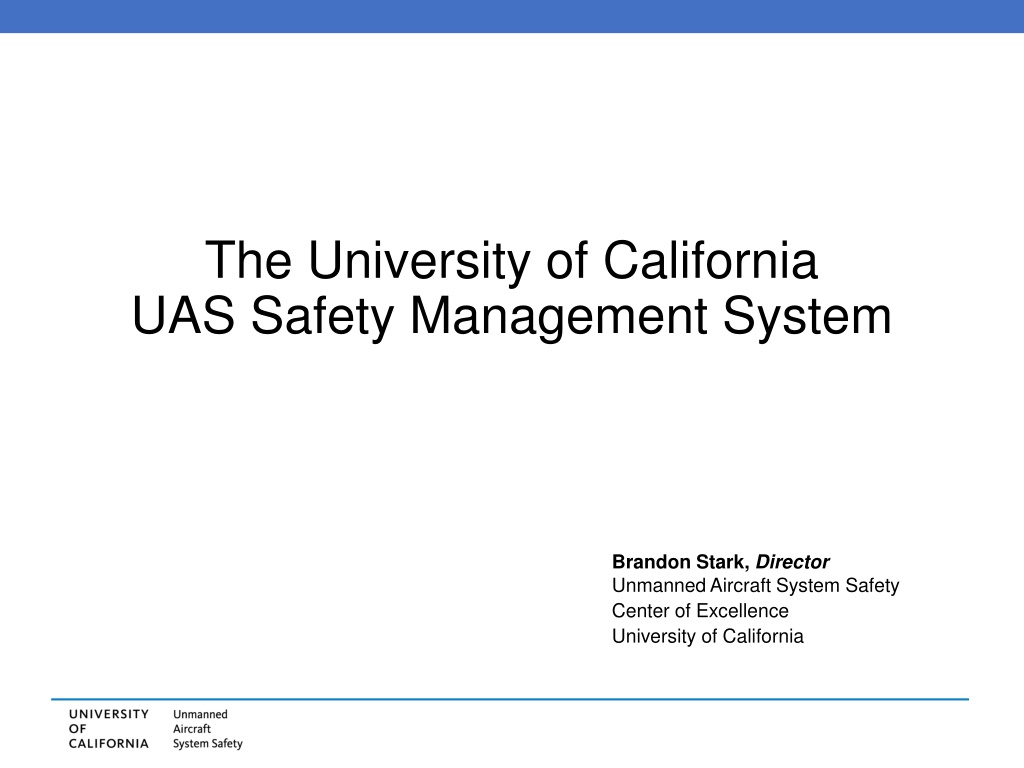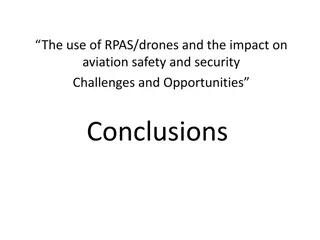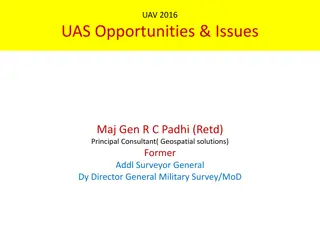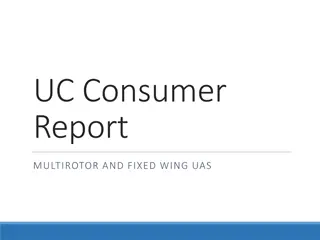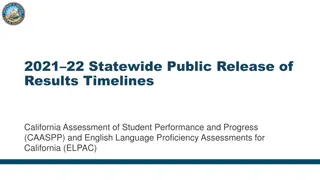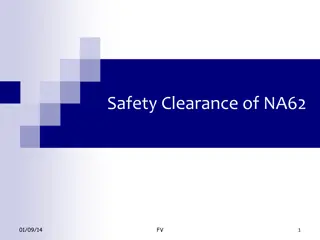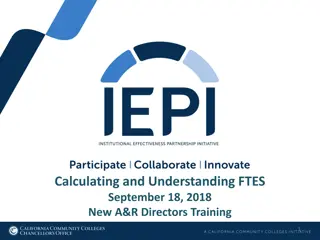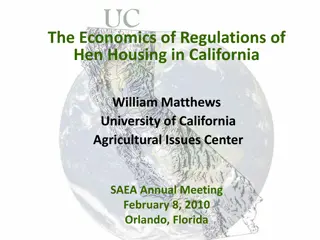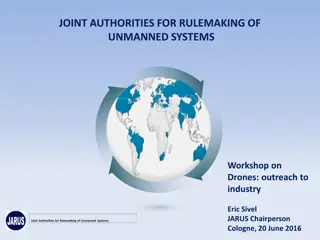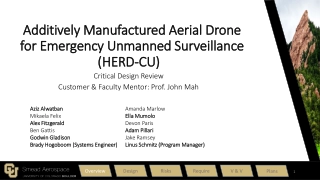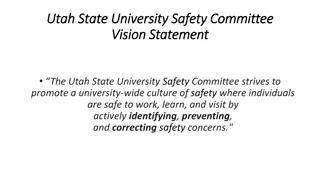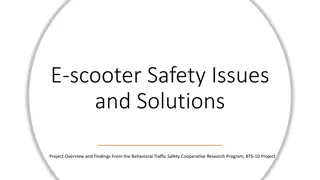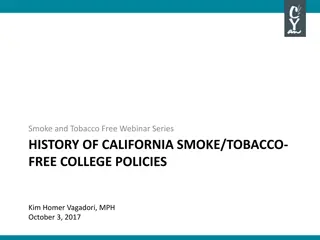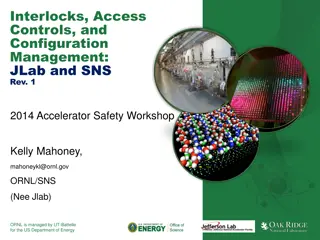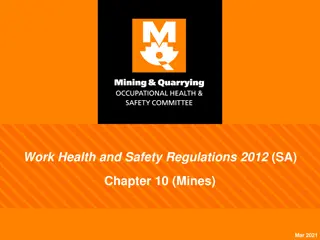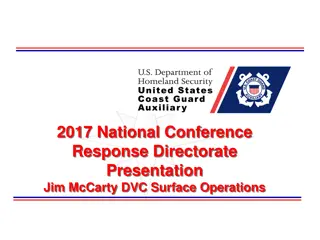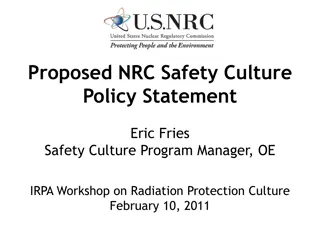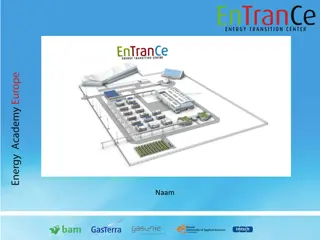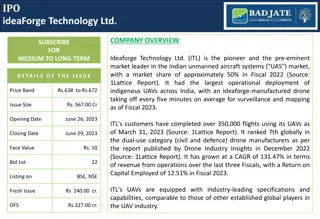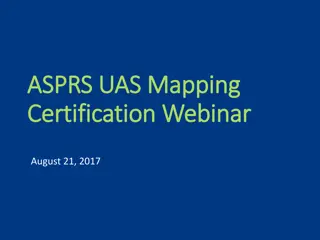University of California UAS Safety Management System Overview
Explore the University of California's UAS Safety Management System, led by Brandon Stark, Director of the Unmanned Aircraft System Safety Center of Excellence. Discover the existing UAS activities within the UC system, common UAS vocabulary, services provided by the Center of Excellence on Unmanned Aircraft System Safety, and distinctions between UAS and model aircraft. Learn about flight authorizations for UC operations and more in this comprehensive presentation.
Download Presentation

Please find below an Image/Link to download the presentation.
The content on the website is provided AS IS for your information and personal use only. It may not be sold, licensed, or shared on other websites without obtaining consent from the author. Download presentation by click this link. If you encounter any issues during the download, it is possible that the publisher has removed the file from their server.
E N D
Presentation Transcript
The University of California UAS Safety Management System Brandon Stark, Director Unmanned Aircraft System Safety Center of Excellence University of California
Topics UAS Safety Safety Management System Policies Risk Management Safety Assurance Safety Promotion Moving forward 2
What UAS activity is already occurring in the UC system? Nearly every campus has a Drone Lab Largely Engineering groups Increased interest in Environmental, Agricultural, Archeological, and Ecological research groups Journalism, Facility Management, Publicity/Multimedia groups 3
UAS Vocab UAS Unmanned Aircraft System COA Certificate of Authorization, applies for both Public Agencies or Commercial UAS flights Part 107 New SUAS Regulations (Aug 29th, 2016) Pilot Certificate Pilot s license Remote Pilot Certificate New SUAS RPIC license RPIC Remote Pilot in command UAS Registration Each aircraft must have an FAA number (starts with N or FA) SUAS Small UAS (under 55 lbs) Section 333 Exemption Congressional exemption from the prohibition of commercial UAS flights VO Visual observer 4
Center of Excellence on Unmanned Aircraft System Safety One-stop shop for all things UAS Services Answer any question about drones, regulations, safety, risk management, applications or research Files permissions and requests on behalf of faculty/staff Provide reports on UAS activity UAS Safety Management System 5
UAS or Model Aircraft Aircraft Model Aircraft are defined as a subset of Unmanned Aircraft. Unmanned Aircraft Small Unmanned Aircraft Model Aircraft are differentiated from Unmanned Aircraft only by the purpose in which they are flown Model Aircraft Sec 336 in H.R. 658 The FAA Modernization and Reform Act of 2012 6
How does the UC get flight authorizations Details in a separate presentations Public Agency Operations (PAO) UC-Owned Aircraft Only for public research purposes No hard-restrictions on operations International students Recreation/Education Student Recreation Student Curriculum Not for research Stop Not Legal Section 333 Exemption UC-Owned Aircraft Only specific UAS models allowed Requires Private Pilot s License Used for very specific cases Small UAS Regulations (Part 107) Any aircraft Requires SUAS License ($150) Up to 400 ft, Line of Sight, Daylight only For Research, Commercial, University Business, Journalism, Film and Photography 7
UC User Flight Workflow Registered Aircraft Where: When: Purpose: Pilot: Aircraft: Flight Request To Center (UC form) Licensed Pilot Flight Report (UC form) Fly! Flight Authorized Clear Airspace File special permission with FAA Details in a separate presentations
UC UAS Activity How many UAS does the UC system have? According to the FAA 9 According to UCOP Risk Services 73 According to my list 130 The true number ~ 200-300 Where are the UASs flown? According to the FAA only in Davis and Merced since 2009 According to the news media All over the US and the world How many illegal UAS flights are being done by our UC students/faculty and staff? The UC has a UAS problem! 9
Whats going wrong? Lack of knowledge of UAS regulations Don t blame recent changes! UAS have been heavily regulated since 2005 Recent changes have only decreased the number restrictions (by adding more alternative process with new rules) Affects both for end-users and the campus administrators Lack of value-added oversight Current reporting mechanisms offer no improvement to regular use Hard to encourage buy-in 10
Legal Safe Just because you follow the letter of the law does not mean that you are guaranteed to be safe
Aviation Safety Management Fly Historical Data Incident Severity Risk Index Fix Crash Even in model-building analysis, we still utilize statistics and probability to derive our risk management analytics
Aviation Safety Management Unmanned Aircrafts have no historical data and technology developments far outpaces data collection effectiveness Fly Historical Data Incident Severity Risk Index Fix Crash Even in model-building analysis, we still utilize statistics and probability to derive our risk management analytics
Introduction to Safety Management Systems Ensuring safety with Unmanned Aircrafts requires a different approach that 1. Incorporates a dynamic risk management systems 2. Has built in mechanisms for improvement and 3. Scales appropriately to risk This is exactly why the FAA has spent the past decade developing what is now known as Safety Management Systems (2006)
UAS Safety Management System Safety Policies Policies hierarchy and responsibilities at each level. They establish oversight requirements and processes to meet safety goals establish the organizational Safety Risk Management Provides a workflow for a formal process to describe the system, identify hazards, assess risk, and control/minimize risk. Safety Assurance Enable the evaluation of the effectiveness of risk management strategies and ensure compliance with other oversight including the FAA, the Center, and OPRM. Safety Promotion Educational outreach on UAS policies and FAA regulations, training on UAS Risk Management and Safety Assurance. Developing a safety culture at all levels of UAS operations. entities,
Safety Risk Management & Safety Assurance Safety Risk Management and Safety Assurance are two separate processes But its useful to think about how they interact
Safety Risk Management Safety requires effective practices in managing risk from The Aircraft The Environment The Human Process Identify hazards Risk Analysis and Assessment Controls for Risk Residual Risk System Operation
How to identify hazards? Crashing in to people, property, etc Loss of Visual Sight Untrained operator Too windy Area not big enough Apparent Autopilot settings Improper failsafe controls Improper training Powerlines or other hard to see obstructions Uncontrolled ground access Flight path clearance Detailed High temperature or elevation Loose screws Rolling terrain wind hazards Updrafts and downdrafts Human Factors (fatigue, rush, etc) Emergency path planning Component wear Hidden
Safety Is the human trained? Each component is required for safety! Is the airspace safe? Is the aircraft ready to fly? This chain helps us identify some risks, but not all
Visualizing the system to identify hazards Software Hardware Environment Liveware Liveware H Use the SHELL Model to think about 1. Interaction within each component and 2. between each component S L E L See Hazard Identification Questionnaire Pamphlet
SHELL Model Software Bugs in code Process errors Hardware Airframe issues Other equipment failures Environment Weather conditions Liveware Fatigue Lack of training Liveware Management failure Software Hardware Environment Liveware Liveware H S L E L
SHELL Model Human Factors are a major component of hazards Software How the user interacts with the non-physical aspects Programming/Planning Checklists/Processes Hardware Liveware Man & Machine Ground Control Equipment Environment Man vs the environment Too hot->inattention Man vs the workplace environment Liveware Liveware Communication failures Liveware Software Hardware Environment Liveware Liveware H S L E Liveware L After we identify hazards, we must analyze them
Analyze Hazards Predictive Models Quantitative Statistics Experience Risk Assessment
Risk Probability and Severity Risk Probability Table Severity Table Likelihood Meaning Value Severity Meaning Value Frequent Likely to occur many times 5 Catastrophic Equipment destroyed, deaths 5 Occasional Likely to occur sometimes 4 Hazardous A large reduction in safety margins, serious injury, major equipment damage 4 Remote Unlikely to occur, but possible 3 Major A significant reduction in safety margins, serious incident, injury 3 Improbable Very unlikely to occur 2 Extremely Improbable Almost inconceivable to occur 1 Minor Nuisance, use of emergency procedures, minor incident 2 Negligible Few consequences 1
Risk Matrix Risk Catastrophic Hazardous Major Minor Negligible 25 20 15 10 5 Frequent 20 16 12 8 4 Occasional 15 12 9 6 3 Remote 10 8 6 4 2 Improbable 5 4 3 2 1 Extremely Improbable Risk Analysis is a continuous and dynamic process. Our control strategy should account for that.
Control Strategies Human Accountability Flight/Safety Training Crew Briefings Checklists Operations Risk Mitigation Strategies Emergency Procedures Contingency Procedures Airframe Maintenance Checks Testing Procedures Scale Appropriate Risk Mitigation Hierarch of Controls 1. Eliminate the hazard 2. Reduce the hazard level 3. Provide safety devices 4. Provide safety warnings 5. Provide safety procedures Environment Airspace Assessments Weather Assessments Hazard Assessments
Effective Control Strategies Address the weak points in the SHELL Model Software Hardware Environment Liveware Liveware H S L E L
Summary of Mitigation Strategies Teach UAS Safety and Operations prior to operations All pilots and ground crews are briefed before each flight Pilots must have sufficient training Preflight procedures should include Weather Assessment Airspace Assessment Aircraft Assessment/Preflight Checklist Operate only in open/clear areas Follow-up after each operation with Flight records Maintenance records
Best Practices to Be Prepared Always bring a fire extinguisher and/or a bucket of sand as appropriate Always bring a first aid kit Never fly over people Never fly in a manner that creates a hazard to people or property
Safety measures should scale appropriately to the risk Micro Drones < 0.55lbs Rotary-Wing <4.4lbs Fixed-wing or Rotary-wing > 4.4 lbs Unsupervised Supervision Recommended Supervised Indoor Outdoor Outdoor License not necessary SUAS License strongly recommended SUAS License for Instructor Aggregate Flight Records Record each flight Record each flight Fire Extinguisher Class D Fire Extinguisher Class D Fire Extinguisher How do we know that our control measures are effective?
Safety Assurance Safety Risk Management and Safety Assurance are two separate processes But they must be able to share information What are we looking for? What are the key performance indicators (KPI)?
What can we record? Anything a person can write down Items that can be pulled Airspace class, weather conditions, aircraft usage, pilot experience Aircraft telemetry Flight paths, aircraft orientation, sensor readings,
What are we looking for in the records? Usage rates Aircraft type, location, altitudes Incident rates Separated between human factors, environmental factors and equipment failures
Data Acquisition Pilot experience Ground crew experience Aircraft Usage Component Wear Battery monitoring Safety Statistics Location Airspace Weather Hazards Flight Requests Pilot information Aircraft information Location Date/Time Flying over people Purpose of flight Flight Records Pilot information Ground crew information Aircraft information Location Date/Time Number and duration of each flight Operation Survey Incidents Accidents Near-misses Legality Airspace Deconfliction End-results Trends/Analysis
Aircraft Telemetry What does it tell us? Moderately useful for data mining More useful for incident reports, post-crash analysis Validate operational controls/restrictions What is useful? Position/Speed Validate geofences Validate airspeed restrictions Communication Packets Identify momentary loss of communication or sensor readings Length of Flight Simplify data entry
UAS Safety Management System Safety Policies Policies hierarchy and responsibilities at each level. They establish oversight requirements and processes to meet safety goals establish the organizational Safety Risk Management Provides a workflow for a formal process to describe the system, identify hazards, assess risk, and control/minimize risk. Safety Assurance Enable the evaluation of the effectiveness of risk management strategies and ensure with other entities, including the FAA, the Center, and OPRM. compliance oversight Safety Promotion Educational outreach on UAS policies and FAA regulations, training on UAS Risk Management and Safety Assurance. Developing a safety culture at all levels of UAS operations.
Effective Policies Minimum Standards for Authorizations and Reporting Advisory Board for reviews and audits System-wide Policies Use of campus grounds, resources Training and usage requirements Policy enforcement Campus Policies Department Policies Equipment use Reporting compliance
Example Campus Policies Restricting UAS usage to specific locations on campus grounds Requiring additional training for the operation of UC-owned equipment Requiring field-safety training for off-campus UAS usage Formalizing a process for a UAS request, including student club or 3rd party commercial Requiring authorization for indoor flights Campuses can manage their own authorization/reporting system Ban using a drone to spy, trespass, interfere with campus activities, etc Restrictions on the purchasing of equipment
What isnt allowed Policies cannot waive federal regulations All non-recreational UAS activity requires a license Campus policy cannot ban all drones from flying over campus Only the FAA can regulate airspace. Campus can ban the operation of drones on campus grounds, or ban drones from taking off/landing on campus grounds Requiring additional equipment for any aircraft in the airspace above campus Campus can require equipment for drones that are operated on campus grounds
Compliance The FAA requires that the (1) remote pilot in command, (2) owner, or (3) person manipulating the flight controls make available to the FAA, upon request, (1) Remote Pilot Certificate with small UAS Rating (2) Any document, record, or report on (a) Aircraft registration (b) Flight records (c) Incident reports (d) Deviation from regulations (e) Authorization from ATC (as appropriate) (f) Waiver from specific provisions (as appropriate)
Compliance The FAA requires that the (1) remote pilot in command, (2) owner, (3) person manipulating the flight controls , or (4) visual observer To allow the FAA, upon request, to test or inspect (1) The SUAS (2) The remote pilot in command (3) The person manipulating the flight controls (4) The visual observer
Compliance The FAA requires that the remote pilot in command to file a report to the FAA within 10 days of any incident that causes (1) Serious injury to any person or any loss of consciousness (2) Damage to any property, other than the SUAS, greater than $500
UC Policy Compliance Requires compliance with FAA regulations Requires compliance with UC Insurance Policy Includes Prior authorization Campuses may manage their own authorization/reporting system Operate in a manner that ensures public safety, right to privacy, civil rights and civil liberties
UC Insurance Compliance Automatic coverage for UC-owned aircraft Under 55 lbs Flight operations are within line of sight Flight operations are below 400 ft For official UC-business (including research) Any UAS s that do not meet these criteria must be approved by the underwriter before they can be covered.
Means for Reporting Compliance UC Risk Services is developing a systemwide resource for authorizations and reporting Until its active, there are temporary forms available at uassafety.ucmerced.edu
UAS Safety Management System Safety Policies Policies hierarchy and responsibilities at each level. They establish oversight requirements and processes to meet safety goals establish the organizational Safety Risk Management Provides a workflow for a formal process to describe the system, identify hazards, assess risk, and control/minimize risk. Safety Assurance Enable the evaluation of the effectiveness of risk management strategies and ensure with other entities, including the FAA, the Center, and OPRM. compliance oversight Safety Promotion Educational outreach on UAS policies and FAA regulations, training on UAS Risk Management and Safety Assurance. Developing a safety culture at all levels of UAS operations.
Safety Promotion UC Center of Excellence on UAS Safety Production of UC UAS Fleet Management System Yearly visits to campuses Two UAS listservs UC-UAS-EHS-L for EH&S, Risk and Campus Safety UC-UAS-RESEARCH-L for researchers and other end-users Develop presentations and other resources Training material and videos
Safety Promotion Safety must be communicated at all levels Resources are available for campuses to use, modify and distribute Recommended Targets New Student Orientations Student Club Training Laboratory Safety Training Field Safety Training
UAS Safety Management System Safety Policies Policies hierarchy and responsibilities at each level. They establish oversight requirements and processes to meet safety goals establish the organizational Safety Risk Management Provides a workflow for a formal process to describe the system, identify hazards, assess risk, and control/minimize risk. Safety Assurance Enable the evaluation of the effectiveness of risk management strategies and ensure compliance with other oversight including the FAA, the Center, and OPRM. Safety Promotion Educational outreach on UAS policies and FAA regulations, training on UAS Risk Management and Safety Assurance. Developing a safety culture at all levels of UAS operations. entities,
Expect a flood of UAS activity! It will come from all sides Researchers Student Clubs Campus Staff Facility Management Visitors
